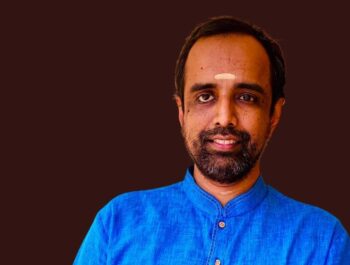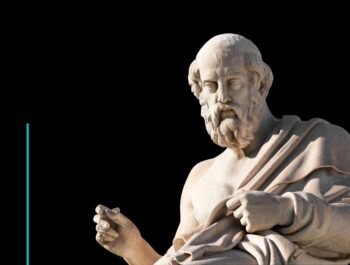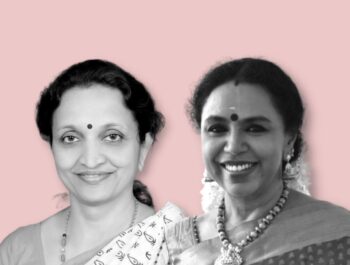Of the various culture and thought centres that have impacted Bharat, Kashmir has been a huge source of many creativity-generating and paradigm-shifting offerings. Different poetic works from the rest of ancient and medieval India mention Kashmir/Sharada Peetha as the yearned destinations or dream locations for their characters. Folk narratives from the rest of India have kings, princes, and princesses of Kashmir as their celebrated characters. Itihasas and Puranas from the rest of India praise the maahaatmya of the tirthas and Kshetras of Kashmir. Besides hosting several punya tirthas and punya sthalas that have attracted the rest of Bharat for ages, Kashmir has also sent seekers to the rest of Bharat. Sharada Desh has been a center of learning for traditional knowledge systems from other regions and has sent learners to similar centres of learning across the country. There has been a continuous exchange of learning and learners between Kashmir and the rest of Bharat.
Kashmir has been mentioned in Panini’s Asthadhyayi, Mahabharat, Puranas and Brihat Samhita (Kumari, 1968). Patanjali, Abhinavagupta, Vishnu Sharma, Bilhana, Kalhana and Bhamaha are some of the eminent scholars from this region. Vasugupta’s Shiva Sutra is an important text of the Advaita tradition of Kashmir Shaivism. According to Kalhana, the first known king of the region was Gonanda (in 1000 BC). The Native king of Kashmir who minted coins in the early 6th century was Pravarsena. In Nilmat Purana, sage Vaisampayana tells king Janmayjeya that the Goddess Uma is the same as Kashmira and that the holy region of Kashmira is possessed of all sacred places. The entire region of Kashmir is described as a Maha Teertha in Nilmat Purana, with every inch of land akin to a Teertha. Sharada Peeth was regarded as a great center for learning. Alberuni mentions Devi Sharada in his account of the most famous idols of the Hindus, right after the image of the Surya Deva at Multan, Vishnu Cakraswamin of Thanesvar and the Linga of Somnath (Kalhana’s Rajatarangini, 1900/2007).
Kalhana’s Rajatarangini indicates that people from various regions of the modern-day India would come to Kashmir for pilgrimage and/or studies. There were special Mathas for people from different regions. Sharada Desh Kashmir was known as Second Benares for the kind of knowledge and learning that emanated from the region. The impact of Kashmiri researchers, philosophers, scholars, and practitioners in various fields of study has contributed to human civilization in various forms. Several works like “Contribution of Kashmir to Sanskrit Literature” by Dr K S Nagarajan (1970) substantiated the contribution of Kashmir in the areas of Poetics, Poetry, Philosophy, Tantra, ancient Indian History-writing etc.
Aalankaarikas from Kashmir have contributed the largest number of paradigms of Sanskrit poetics such as the theories of Rasa, and kaavyaatma /kaavyajeevita paradigms of Dhvani, Vakrokti and Auchitya, among others. What came to be known as Kashmir -Shaivism is the most robust overarching system of theory and practice that has impacted the Shaakteya, Sri Vidya, Kerala Tantra and several other traditions of theory and practice, throughout the length and breadth of our sacred geography. Through the work of Abhinavagupta, the polymath from Kashmir, this system became the integrator of multiple fields such as Shaastras of Naatya, Kaavya, Yoga, Vedanta, and Tantra.
Adi Shankara from Kerala made Sharada Peetha of Kashmir as his final destination of digvijaya yaatra. While leaving an indelible mark on Kashmiri people’s spiritual culture, he brought Sharada and Chandramauli from Kashmir to the four Aamanaaya Peethas established by him in the four corners of India.
To celebrate the integral significance of Kashmir for the rest of Bharat and vice versa, INDICA is organizing a conference in the month of September 2022. This is a call for papers from students, scholars, experts, and public intellectuals. The conference is being curated by Dr. Nagaraj Paturi, Senior Director – INDICA and Dimple Kaul, Servant Leader – INDICA Courses.
We invite papers focusing on the theme of the conference, across various fields of study such as History, Philosophy, Linguistics, Literature, Art etc. Participants could also share their research on specific sub-themes such as the contribution of Kashmir to Sanskritik civilization, Kashmir Shaivism, Energy centers in Kashmir, Shiv Sutras etc.
Guidelines for paper submission
Author
Include name (spelled out as it would be cited), affiliations and e-mail addresses and contact numbers after the paper title (the contact details (email/mobile number) will not be published but may be needed as contact information during the process).
Abstract
- Abstracts of the paper should cover just the proposition and /or argument of the paper succinctly
- It should not exceed 500 words
- Please use Times New Roman, font size 12 with 1.5 line spacing
- The abstract should be accompanied with a list of references that are going to be used in the paper, and /or a pointer to an existing published work, theory argument which the paper is supporting, extending, or countering a response
- The selected papers are going to be published on INDICA Today after the conference. An acceptance for the same should accompany the abstract
- An assurance that the paper has not been published or will not be published on any other platform should also accompany the abstract
- Submission must be emailed, latest by June 30th, 2022, to namaste@Indica.org.in with the subject line: Conference on Kashmir – Cultural Epicentre of Bharat
Paper and Presentation
- The last date for the submission of papers for the selected abstracts is August 15th, 2022
- There is no world limit for the selected paper
- Please use Times New Roman, font size 12 with 1.5 line spacing, APA style sheet
- Selected papers will be presented in the conference scheduled on the 16th & 17th of September 2022. The venue of the Conference will be announced in due course
- The duration of each presentation will be 15 minutes, including Q&A. Selected presenters will have to prepare their decks accordingly
Reference List
- Please follow APA formatting for in text and end references. Include a reference list at the end of the paper so that readers can make full use of the citations
- Include all works that are cited in the chapter and that have been published (including on the Internet) or accepted for publication. Personal communications and unpublished works should only be mentioned in the text
- Entries in the list must be listed alphabetically
Permissions
If the paper includes any excerpts from copyrighted works (including websites) such as illustrations, tables, animations, or text quotations, it is necessary for the author to obtain permission from the copyright holder (usually the original publisher).
References
Kalhana’s Rajatarangini (M. A. Stein, Trans.; Vol. II). (2007). Gulshan Books. (Original work published 1900)
Kumari, Dr. V. (1968). The Nilmat Purana – A Cultural and Literary Study of a Kashmiri Purana (First, Vol. 1). J&K Academy of Art, Culture and Languages.







